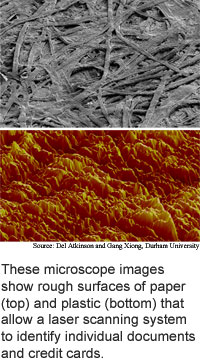
Textures
ID paper and plastic
Researchers from Imperial
College London, Durham University and the University of Sheffield in England
have developed a way of uniquely identifying documents, credit cards and
product packaging.
The method involves scanning using ordinary laser scanners to
produce unique identification numbers based on the microscopic textures
of the objects' surfaces. An object is authenticated by scanning it and
comparing the results to a scan made at the time the object was manufactured.
The method hinges on the ability of lasers to record the patterns
of microscopic surface features and on the lack of any known method of
reproducing or altering those features.
The probability of any two pieces of paper sharing the same surface
fingerprint is 10-72, according to the researchers. This is
less than one in the estimated number of atoms in the universe. For smoother
surfaces like plastic and coated paperboard the probability is 10-20,
which is less than one in 100 billion billion.
The researchers' prototype scanner shoots a laser beam across
a surface and records the intensity of the reflected light via four photodetectors.
As the lightwaves bounce off the microscopic hills and valleys of the
surface, they interfere with each other to increase and decrease the light's
intensity. The fluctuations in intensity above and below the mean value
are converted into the 1s and 0s of a digital code.
The challenge to making the system practical was tuning the system
to record the intrinsic microscopic irregularities while ignoring creases,
dirt and other alterations, according to the researchers.
The researchers tested the method by scanning a piece of paper
to get the initial measurement, then wadding it up, soaking it in water,
scorching it, scribbling on it with ballpoint pen and marker, and scrubbing
it with an abrasive cleaning pad. Despite the abuse, they were able to
identify the paper using the method.
The method can be used now, and the researchers have launched
a startup company to commercialize the technology. The work appeared in
the July 28, 2005 issue of Nature ('Fingerprinting' documents and
packaging).
Stories:
System carries PC soul
Letter: a short history of TRN
Plug-in protects passwords
Ice transforms chipmaking
Pixels speed quantum crypto
Briefs:
Textures ID paper and plastic
DNA process stamps patterns
Templates yield nano branches
Chemistry moves micro machines

Research Watch blog
View from the High Ground Q&A
How It Works
RSS Feeds:
News
Ad links:
Buy an ad link
Ad links: Clear History
Buy an ad link
|
TRN
Newswire and Headline Feeds for Web sites
|
© Copyright Technology Research News, LLC 2000-2010. All rights reserved.